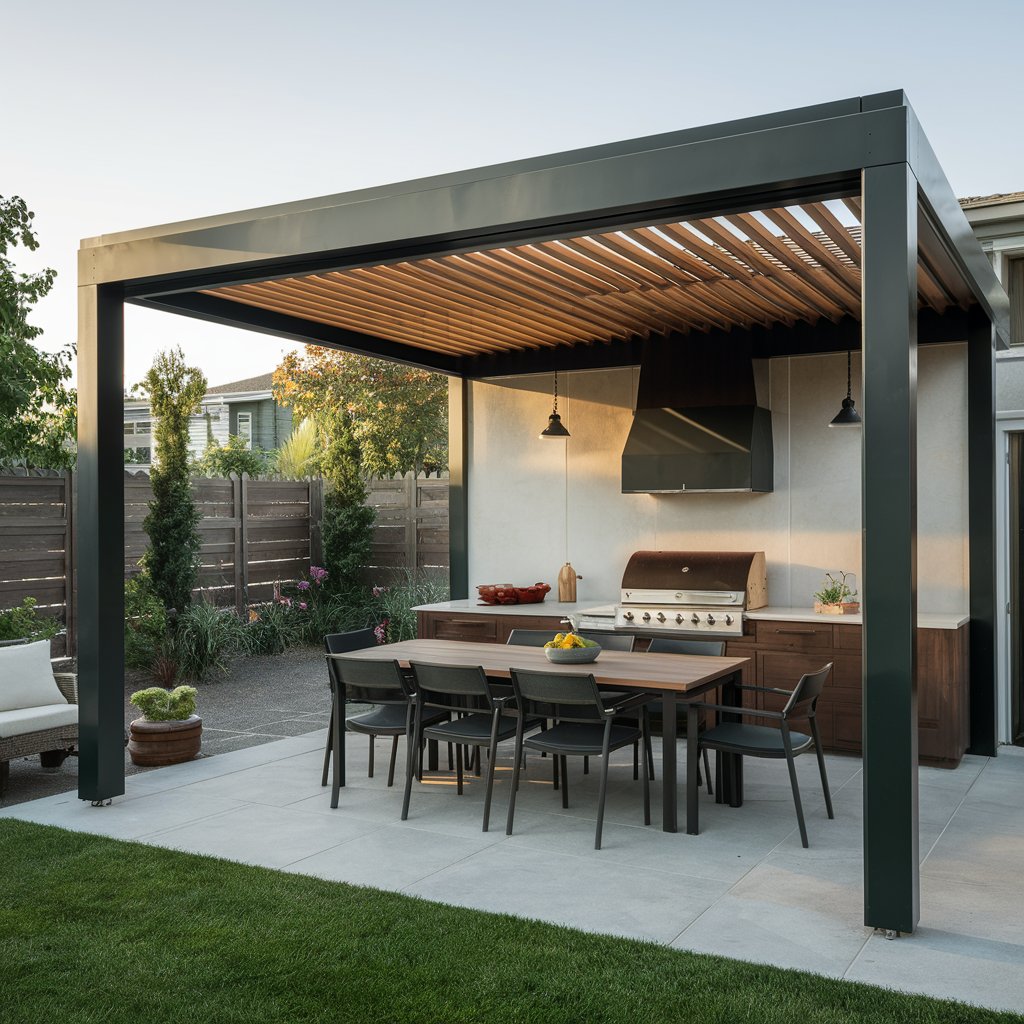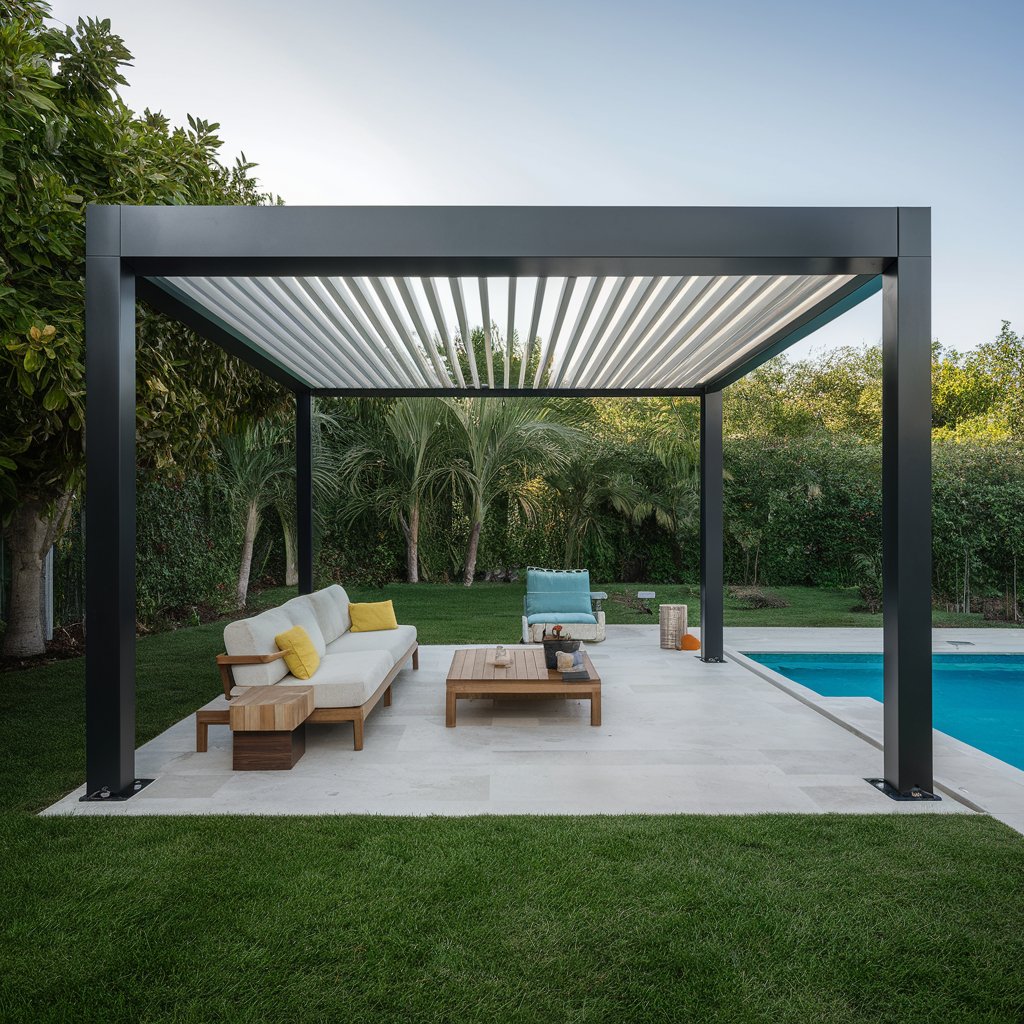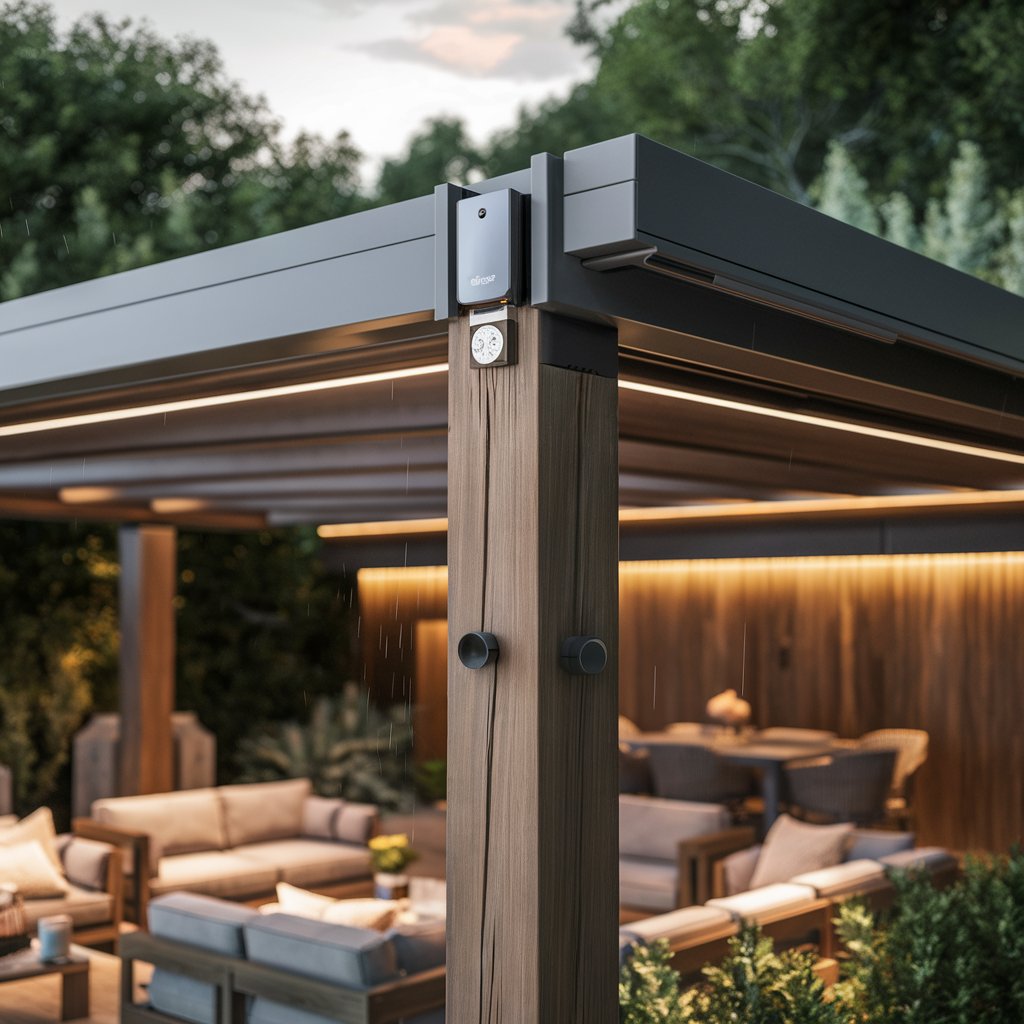
In the realm of outdoor living spaces, the high quality pergola stands out as a timeless and versatile structure. Whether you are looking to enhance your garden, patio, or backyard, a high-quality pergola can significantly elevate the aesthetic and functional appeal of your outdoor area. This article delves into the benefits, design options, materials, and considerations that make a high-quality pergola an excellent investment for any homeowner.
1. The Benefits of a High-Quality Pergola
1.1 Enhanced Outdoor Living
A high-quality pergola extends your living space into the outdoors, providing a perfect setting for relaxation, dining, and entertaining. By creating a defined area that blends the comfort of indoor living with the natural beauty of the outdoors, pergolas make it possible to enjoy your garden or patio year-round.
1.2 Aesthetic Appeal
A well-designed pergola adds visual interest and architectural flair to your outdoor space. It can serve as a focal point, drawing attention to specific areas of your garden or providing a beautiful frame for climbing plants and vines. The variety of styles and customization options available ensure that you can find a pergola that complements your home’s architecture and landscape design.
1.3 Increased Property Value
Investing in a high-quality pergola can enhance the overall value of your property. Potential buyers often view outdoor living spaces as valuable extensions of the home, and a pergola can be a standout feature that sets your property apart. A beautifully designed and well-maintained pergola demonstrates attention to detail and a commitment to quality, making your home more appealing on the real estate market.
1.4 Functional Flexibility
High-quality pergolas are incredibly versatile, offering various functions depending on your needs. They can provide shade during hot summer days, protection from light rain, and even support for outdoor lighting and heating systems. This flexibility makes pergolas suitable for a wide range of activities, from casual lounging to formal dining and lively gatherings.
1.5 Environmental Benefits
Pergolas can also offer environmental benefits. For example, they can be designed to support solar panels, providing a sustainable energy source. Additionally, pergolas with living roofs or vertical gardens contribute to biodiversity and improve air quality by supporting plant growth.
2. Choosing the Right Materials
The choice of materials is a critical factor in the durability, appearance, and maintenance requirements of your pergola. Here are some popular options for high-quality pergolas:
2.1 Wood
Wooden pergolas offer a classic and natural look that blends seamlessly with outdoor environments. Common choices include cedar, redwood, and pressure-treated pine. These woods are known for their durability and resistance to decay and insects. However, wood requires regular maintenance, such as staining or sealing, to protect it from the elements and maintain its appearance.
- Cedar: Cedar is naturally resistant to rot, decay, and insect infestations. It has a pleasant aroma and a beautiful grain that can enhance the aesthetic of your pergola. Regular sealing or staining can help preserve its color and longevity.
- Redwood: Similar to cedar, redwood is durable and resistant to pests and decay. It has a rich, warm color that can be maintained with regular treatment or allowed to weather to a natural gray.
- Pressure-Treated Pine: This is a more affordable option that has been treated with chemicals to resist decay and insects. While it requires more maintenance to prevent warping and cracking, it can be a cost-effective choice for those on a budget.
2.2 Aluminum
Aluminum pergolas are lightweight, durable, and resistant to rust and corrosion. They require minimal maintenance and can be powder-coated in various colors to match your aesthetic preferences. Aluminum is an excellent choice for homeowners seeking a modern, sleek look without the upkeep associated with wood.
- Durability: Aluminum pergolas can withstand harsh weather conditions without deteriorating. They are resistant to rust, corrosion, and fading, making them ideal for coastal or humid environments.
- Low Maintenance: Unlike wood, aluminum does not require regular staining or sealing. A simple wash with soap and water is usually sufficient to keep it looking new.
- Customization: Aluminum pergolas can be powder-coated in a wide range of colors and finishes, allowing for greater customization to match your home’s style.
2.3 Vinyl
Vinyl pergolas are low-maintenance and resistant to rot, mold, and pests. They are available in various styles and colors, offering a durable and cost-effective option. Vinyl pergolas are ideal for those who want a hassle-free structure that retains its appearance over time.
- Durability: Vinyl is highly resistant to weathering, making it an excellent choice for areas with extreme weather conditions. It does not crack, warp, or peel, ensuring long-term performance.
- Ease of Maintenance: Vinyl pergolas require minimal maintenance. They do not need to be painted or stained, and they can be easily cleaned with a hose or mild detergent.
- Aesthetic Options: While vinyl may not offer the same natural look as wood, it is available in a variety of colors and styles, including designs that mimic the appearance of wood.
2.4 Composite
Composite pergolas combine the natural look of wood with the durability of synthetic materials. They are resistant to weathering, insects, and decay, making them a long-lasting choice. Composite materials often require less maintenance than wood and can be designed to mimic the appearance of various wood types.
- Durability: Composite materials are designed to withstand the elements without rotting, cracking, or fading. They are resistant to insects and moisture, making them ideal for long-term use.
- Low Maintenance: Like vinyl and aluminum, composite pergolas require minimal maintenance. They do not need to be painted or stained and can be cleaned with soap and water.
- Aesthetic Appeal: Composite materials can be manufactured to closely resemble natural wood, offering the beauty of wood without the associated upkeep.
3. Design and Customization Options for high quality pergola
One of the key advantages of high-quality pergolas is the ability to customize them to fit your specific needs and preferences. Here are some design and customization options to consider:
3.1 Roofing
The roofing element of a pergola can range from open slats to fully covered designs. Options include:
- Open Slats: Provide partial shade while allowing sunlight and air to flow through. This design is ideal for growing climbing plants, as it allows for natural light and rain to reach the plants.
- Retractable Canopies: Offer flexibility by allowing you to open or close the roof as needed. Retractable canopies provide the option of full sun, partial shade, or complete coverage, depending on the weather and your preferences.
- Solid Panels: Provide complete protection from the sun and rain, creating a fully sheltered space. Solid panels can be made from materials like polycarbonate, metal, or fabric, offering varying degrees of light transmission and durability.
3.2 Shape and Style
Pergolas come in various shapes and styles, from traditional rectangular designs to more elaborate circular or hexagonal structures. Choose a shape that complements your outdoor space and meets your functional needs.
- Rectangular Pergolas: The most common shape, offering a straightforward and versatile design suitable for most spaces.
- Circular and Hexagonal Pergolas: These shapes add a unique architectural element and can serve as a striking focal point in your garden or patio.
- Arched and Curved Pergolas: Add a touch of elegance and sophistication with arched beams or curved designs. These styles can create a more dynamic and visually interesting structure.
3.3 Accessories
Enhance your pergola with accessories such as integrated lighting, ceiling fans, curtains, and heaters. These additions can increase comfort and usability, allowing you to enjoy your pergola in various weather conditions.
- Integrated Lighting: Add ambient lighting with string lights, recessed lights, or lanterns. This creates a warm and inviting atmosphere for evening gatherings.
- Ceiling Fans: Improve air circulation and comfort with ceiling fans, especially during hot summer months. Outdoor-rated fans are designed to withstand the elements and provide a cooling breeze.
- Curtains and Shades: Add outdoor curtains or shades to create privacy and block out the sun or wind. Choose weather-resistant fabrics that can withstand exposure to the elements.
- Heaters: Extend the usability of your pergola into cooler months by installing electric or propane heaters. Wall-mounted or freestanding models provide warmth and comfort.
3.4 Landscaping
Incorporate climbing plants, hanging baskets, and surrounding greenery to create a cohesive and inviting environment. Plants like wisteria, grapevines, and climbing roses can add a touch of natural beauty and provide additional shade.
- Climbing Plants: Choose plants that are suitable for your climate and can thrive with the level of sunlight your pergola receives. Climbing plants can create a lush, green canopy that enhances the natural beauty of your pergola.
- Hanging Baskets: Add hanging baskets with colorful flowers or trailing plants to bring additional greenery and color to your pergola.
- Surrounding Greenery: Integrate your pergola into your garden by planting shrubs, flowers, and ground cover around the base. This helps create a seamless transition between your pergola and the rest of your outdoor space.
4. Installation and Maintenance
4.1 Professional Installation
While some homeowners may opt for DIY installation, hiring a professional ensures that your pergola is built correctly and safely. Professionals can handle complex designs and provide warranties on their work, giving you peace of mind.
- Expertise: Professional installers have the experience and knowledge to ensure your pergola is constructed to withstand the elements and meet local building codes.
- Time and Effort: DIY installation can be time-consuming and physically demanding. Hiring a professional saves you time and effort, allowing you to enjoy your new pergola sooner.
- Quality Assurance: Professionals can identify and address potential issues during installation, ensuring a high-quality and durable structure.
4.2 Regular Maintenance
Maintaining a high-quality pergola involves regular cleaning and inspections. Wooden pergolas may require periodic staining or sealing, while aluminum, vinyl, and composite pergolas typically need less upkeep. Check for signs of damage, such as cracks, rust, or insect infestations, and address any issues promptly to prolong the life of your pergola.
- Cleaning: Regularly clean your pergola to remove dirt, debris, and mildew. Use a mild detergent and water for most materials, and a soft brush or cloth to avoid scratching surfaces.
- Inspections: Periodically inspect your pergola for signs of wear or damage. Look for loose or damaged hardware, cracks in wood or composite materials, and rust or corrosion on metal components.
- Maintenance for Wood Pergolas: Wooden pergolas require more maintenance to protect against the elements. Apply a sealant or stain every few years to preserve the wood and prevent rot and decay.
- Maintenance for Metal Pergolas: Aluminum pergolas are low-maintenance but should be inspected for signs of corrosion or damage. Touch up any scratches or chips in the powder coating to prevent rust.
- Maintenance for Vinyl and Composite Pergolas: These materials are highly durable and require minimal maintenance. Clean regularly and check for any signs of damage or wear.
5. Case Studies: Real-Life Examples of High-Quality Pergolas
5.1 Modern Pergola with Retractable Canopy
In a contemporary suburban backyard, a homeowner chose to install a modern pergola with a retractable canopy. The aluminum structure, powder-coated in a sleek black finish, provides a stylish and durable addition to the outdoor living space. The retractable canopy allows the homeowner to control the amount of sunlight and shade, making the pergola a versatile space for dining, lounging, and entertaining. Integrated LED lighting and a ceiling fan add comfort and ambiance, creating a functional and inviting outdoor retreat.
5.2 Traditional Wooden Pergola in a Garden Setting
A gardening enthusiast decided to enhance their garden with a traditional wooden pergola made from cedar. The natural beauty of the cedar complements the lush greenery and colorful flowers in the garden. Climbing roses and wisteria were planted at the base of the pergola, creating a stunning canopy of blooms and foliage. The homeowner added hanging baskets with trailing plants and outdoor furniture to create a cozy and picturesque seating area. Regular maintenance, including staining and pruning, ensures the pergola remains a beautiful and integral part of the garden.
5.3 Poolside Pergola with Solar Panels
A homeowner with a focus on sustainability installed a high-quality pergola with integrated solar panels next to their pool. The composite pergola provides a shaded area for lounging and dining, while the solar panels generate electricity to power the pool’s filtration system and outdoor lighting. The pergola’s design includes adjustable louvers, allowing the homeowner to control the amount of sunlight and ventilation. The combination of functionality, aesthetics, and sustainability makes this pergola a standout feature in the outdoor space.
6. Trends and Innovations in Pergola Design
6.1 Smart Pergolas
The integration of smart technology into pergolas is a growing trend. Smart pergolas can be equipped with motorized louver systems, retractable canopies, and integrated lighting and heating systems that can be controlled via smartphone or remote control. These features provide convenience and allow homeowners to customize their outdoor environment with ease.
6.2 Sustainable Materials
Sustainability is a key consideration for many homeowners, and the use of eco-friendly materials in pergola construction is becoming more popular. Recycled composite materials, sustainably sourced wood, and solar-powered accessories are some of the options available for creating environmentally responsible pergolas.
6.3 Multifunctional Designs
Modern pergolas are being designed to serve multiple functions, combining elements such as outdoor kitchens, bars, and entertainment systems. These multifunctional pergolas create versatile spaces that can be used for a variety of activities, from cooking and dining to relaxing and socializing.
6.4 Artistic and Unique Designs
Homeowners are increasingly seeking pergolas with unique and artistic designs that reflect their personal style. Custom-built pergolas with intricate woodwork, decorative metal accents, and creative shapes add a touch of individuality and charm to outdoor spaces.
7. Conclusion
A high-quality pergola is a valuable addition to any outdoor space, offering both aesthetic appeal and functional benefits. By choosing the right materials, design, and customization options, you can create a beautiful and durable structure that enhances your home’s value and your outdoor living experience. Whether you prefer the timeless elegance of wood, the modern sleekness of aluminum, or the low-maintenance convenience of vinyl or composite, there is a high-quality pergola to suit your needs and transform your outdoor space into a haven of comfort and style.
Investing in a high-quality pergola is not just about enhancing the look of your garden or patio; it’s about creating a space where you can enjoy nature, entertain guests, and make lasting memories with family and friends. With the right planning, materials, and design, your pergola can become a cherished feature of your home for years to come.


